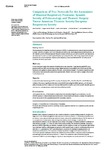Mostrar o rexistro simple do ítem
Comparison of two protocols for the assessment of maximal respiratory pressures: Spanish Society of Pulmonology and Thoracic Surgery versus American Thoracic Society/European Respiratory Society
| dc.contributor.author | Lista-Paz, Ana | |
| dc.contributor.author | Sancho Marín, Sergio | |
| dc.contributor.author | Souto-Camba, Sonia | |
| dc.contributor.author | Jácome, Cristina | |
| dc.contributor.author | González Doniz, Luz | |
| dc.date.accessioned | 2022-01-12T08:36:39Z | |
| dc.date.available | 2022-01-12T08:36:39Z | |
| dc.date.issued | 2021-10-29 | |
| dc.identifier.citation | Lista-Paz A, Sancho Marín S, Souto Camba S, Jácome C, González Doniz L. Comparison of two protocols for the assessment of maximal respiratory pressures: Spanish Society of Pulmonology and Thoracic Surgery versus American Thoracic Society/European Respiratory Society. Cureus. 2021 Oct 29;13(10):e19129. | es_ES |
| dc.identifier.issn | 2168-8184 | |
| dc.identifier.uri | http://hdl.handle.net/2183/29360 | |
| dc.description.abstract | [Abstract] Background. The measurement of maximal respiratory pressures (MRPs) is commonly used to assess respiratory muscle strength. However, in Spain, there is no consensus on which is the most adequate measurement protocol, as the Spanish Society of Pneumology and Thoracic Surgery (SEPAR) protocol differs from the one endorsed by the American Thoracic Society/European Respiratory Society (ATS/ERS). This study compared the absolute and predictive values of maximal expiratory and inspiratory pressures (MEP and MIP) in healthy adults obtained with the two protocols. Methods. A cross-sectional study with a sample of healthy adults was conducted. Lung function and MRPs were assessed. MEP and MIP were measured using a digital manometer according to the SEPAR and ATS/ERS. Protocols were applied in random order by the same trained physiotherapist. The comfort experienced with each protocol was assessed through a short questionnaire. Paired t-tests were used to compare the results from both protocols. Results. A total of 31 subjects (mean age 35.7±12.4 years; 14 females; FEV₁=108.3±10.5%; FVC=103.7±10%) were included. There was a significant difference between MRPs favouring the SEPAR protocol, with the mean difference being 34.9±28.1 cmH₂O (p˂0.001) for MEP and 8±11.6 cmH₂O (p=0.001) for MIP. ATS/ERS protocol was, however, considered more comfortable than SEPAR (p<0.005). Conclusions. This study shows that, in healthy adults, higher MRPs are obtained using the SEPAR protocol. Yet, the ATS/ERS protocol is experienced as more comfortable. Future studies are needed to analyse the application of both protocols in other populations and their associated comfort. | es_ES |
| dc.language.iso | eng | es_ES |
| dc.publisher | Cureus | es_ES |
| dc.relation.uri | https://doi.org/10.7759/cureus.19129 | es_ES |
| dc.rights | Creative Commons Attribution 4.0 International Licence (CC-BY 4.0) | es_ES |
| dc.rights.uri | http://creativecommons.org/licenses/by/4.0/ | * |
| dc.subject | Physical therapy modalities | es_ES |
| dc.subject | Breathing exercises | es_ES |
| dc.subject | Respiratory function tests | es_ES |
| dc.subject | Respiratory muscles | es_ES |
| dc.subject | Maximal respiratory pressures | es_ES |
| dc.title | Comparison of two protocols for the assessment of maximal respiratory pressures: Spanish Society of Pulmonology and Thoracic Surgery versus American Thoracic Society/European Respiratory Society | es_ES |
| dc.type | info:eu-repo/semantics/article | es_ES |
| dc.rights.access | info:eu-repo/semantics/openAccess | es_ES |
| UDC.journalTitle | Cureus | es_ES |
| UDC.volume | 13 | es_ES |
| UDC.issue | 10 | es_ES |
| UDC.startPage | e19129 | es_ES |
| dc.identifier.doi | 10.7759/cureus.19129 |
Ficheiros no ítem
Este ítem aparece na(s) seguinte(s) colección(s)
-
GI-IPRF - Artigos [150]






